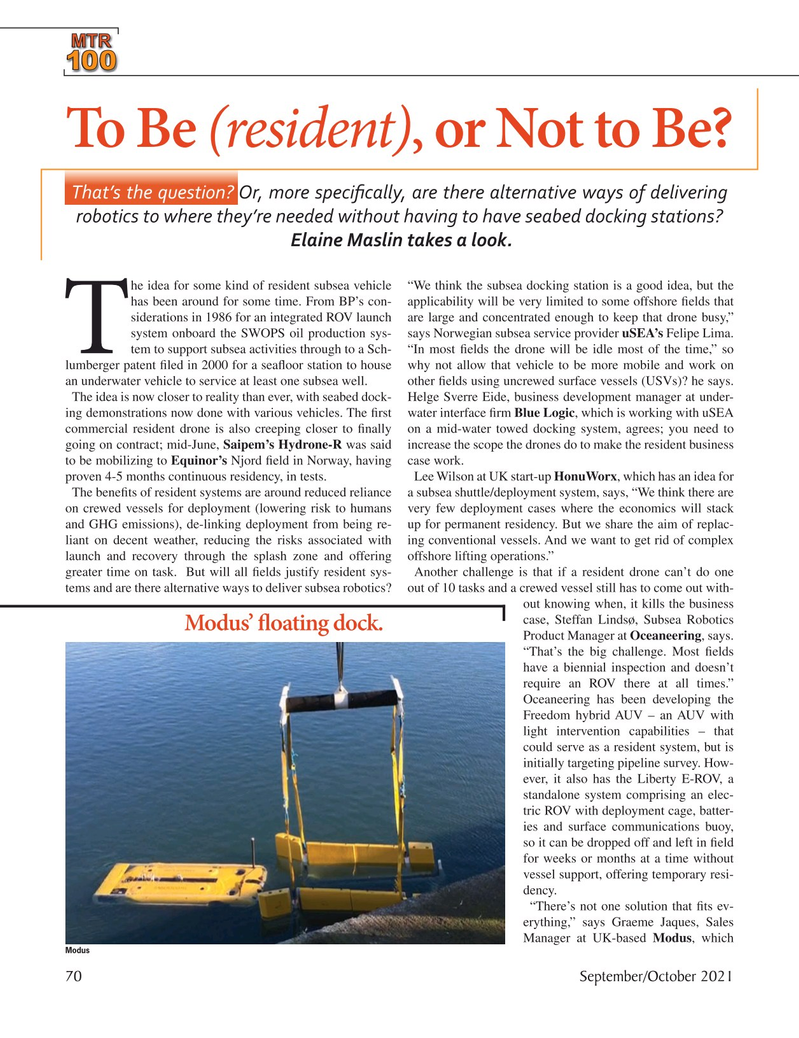
Page 70: of Marine Technology Magazine (September 2021)
MTR100: Focus on 100 Leading Companies, People and Innovations in the Subsea Space
Read this page in Pdf, Flash or Html5 edition of September 2021 Marine Technology Magazine
MTTTTTTTTTTTTTRM M M M M M M M M M M M M M M M M M M M M M M M M M M M MTRRRRRRRRRRRRRRRRRRRRRRRRRRRMTTTTTTTTTTTTTRMTR 100000000000000001111111111111111111111111111100000000000000000000000000000010000000000000000100
To Be (resident), or Not to Be?
That’s the question? Or, more speci? cally, are there alternative ways of delivering robotics to where they’re needed without having to have seabed docking stations?
Elaine Maslin takes a look. he idea for some kind of resident subsea vehicle “We think the subsea docking station is a good idea, but the has been around for some time. From BP’s con- applicability will be very limited to some offshore ? elds that siderations in 1986 for an integrated ROV launch are large and concentrated enough to keep that drone busy,” system onboard the SWOPS oil production sys- says Norwegian subsea service provider uSEA’s Felipe Lima.
Ttem to support subsea activities through to a Sch- “In most ? elds the drone will be idle most of the time,” so lumberger patent ? led in 2000 for a sea? oor station to house why not allow that vehicle to be more mobile and work on an underwater vehicle to service at least one subsea well. other ? elds using uncrewed surface vessels (USVs)? he says.
The idea is now closer to reality than ever, with seabed dock- Helge Sverre Eide, business development manager at under- ing demonstrations now done with various vehicles. The ? rst water interface ? rm Blue Logic, which is working with uSEA commercial resident drone is also creeping closer to ? nally on a mid-water towed docking system, agrees; you need to going on contract; mid-June, Saipem’s Hydrone-R was said increase the scope the drones do to make the resident business to be mobilizing to Equinor’s Njord ? eld in Norway, having case work. proven 4-5 months continuous residency, in tests. Lee Wilson at UK start-up HonuWorx, which has an idea for
The bene? ts of resident systems are around reduced reliance a subsea shuttle/deployment system, says, “We think there are on crewed vessels for deployment (lowering risk to humans very few deployment cases where the economics will stack and GHG emissions), de-linking deployment from being re- up for permanent residency. But we share the aim of replac- liant on decent weather, reducing the risks associated with ing conventional vessels. And we want to get rid of complex launch and recovery through the splash zone and offering offshore lifting operations.” greater time on task. But will all ? elds justify resident sys- Another challenge is that if a resident drone can’t do one tems and are there alternative ways to deliver subsea robotics? out of 10 tasks and a crewed vessel still has to come out with- out knowing when, it kills the business case, Steffan Lindsø, Subsea Robotics
Modus’ f oating dock.
Product Manager at Oceaneering, says. “That’s the big challenge. Most ? elds have a biennial inspection and doesn’t require an ROV there at all times.”
Oceaneering has been developing the
Freedom hybrid AUV – an AUV with light intervention capabilities – that could serve as a resident system, but is initially targeting pipeline survey. How- ever, it also has the Liberty E-ROV, a standalone system comprising an elec- tric ROV with deployment cage, batter- ies and surface communications buoy, so it can be dropped off and left in ? eld for weeks or months at a time without vessel support, offering temporary resi- dency. “There’s not one solution that ? ts ev- erything,” says Graeme Jaques, Sales
Manager at UK-based Modus, which
Modus 70 September/October 2021
MTR #7 (66-79).indd 70 9/22/2021 10:01:45 AM

 69
69

 71
71
